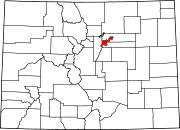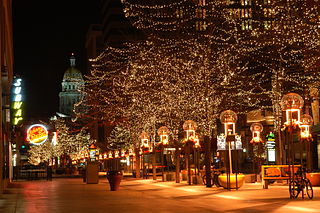
Denver is a consolidated city and county, the capital, and most populous city of the U.S. state of Colorado. It is located in the western United States, in the South Platte River Valley on the western edge of the High Plains east of the Front Range of the Rocky Mountains. With a population of 715,522 as of the 2020 census, a 19.22% increase since 2010, Denver is the 19th most populous city in the United States and the fifth most populous state capital. It is the principal city of the Denver–Aurora–Lakewood metropolitan statistical area, with almost 3 million people the most populous metropolitan area in Colorado. Denver is the economic and cultural center of the broader Front Range Urban Corridor, home to more than 5 million people.

ASARCO is a mining, smelting, and refining company based in Tucson, Arizona, which mines and processes primarily copper. The company has been a subsidiary of Grupo México since 1999.

Auraria was a gold mining camp established in 1858 in the Kansas Territory of the United States. Today it survives in its original location as a neighborhood of Denver, Colorado, immediately south of the confluence of Cherry Creek and the South Platte River.

Located in the city and county of Denver, Colorado, the Capitol Hill neighborhood is bordered by Broadway, Downing Street, Colfax Avenue, and Seventh Avenue, which carry large volumes of traffic around the neighborhood. It is technically located in East Denver which begins immediately east of Broadway, the neighborhood's western boundary. Many consider the Cheesman Park neighborhood to be a part of the Capitol Hill neighborhood, but as defined by the city, Cheesman Park is a separate neighborhood. Denver also recognizes a statistical neighborhood called North Capitol Hill, also known as Uptown by some residents. Colfax Avenue is the border between these two neighborhoods.

Montbello is a neighborhood of Denver, Colorado, located in the far northeast of the city. It is bounded on its north side by E 56th Avenue and the Rocky Mountain Arsenal National Wildlife Refuge, on its south side by the I-70/I-225 junction, by Peoria Street on its western confine and Chambers Road on its east.
Grupo México is a Mexican conglomerate that operates through the following divisions: Mining, Transportation, Infrastructure and Fundacion Grupo Mexico.

Park Hill is a neighborhood in Denver, Colorado, U.S. Located in the northeastern quadrant of the city, it is bordered by Colorado Boulevard on the west, East Colfax Avenue on the south, Quebec Street on the east, and East 52nd Avenue on the north. The entire Park Hill neighborhood is located in the area known as East Denver. It is further divided by the City and County of Denver into three administrative neighborhoods, South Park Hill, North Park Hill, and Northeast Park Hill.

Five Points is one of the oldest neighborhoods in Denver, Colorado. It is now one of the fastest growing in terms of both redevelopment and population. Much of this growth is taking place in the River North Arts District, or "RiNo", which is often considered by locals a neighborhood of its own; although it is officially within the Five Points neighborhood in addition to parts of neighboring Globeville and Elyria-Swansea.

Baker is a neighborhood in Denver, Colorado, United States.
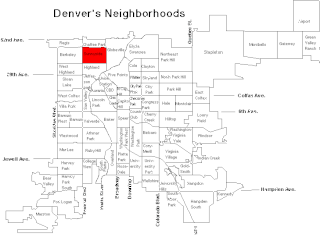
Sunnyside is a city-center neighborhood in Denver, Colorado, located in the Northside of Denver, west of Interstate 25.

Sun Valley is a neighborhood in central Denver, Colorado, bordered by I-25 on the east, Federal Blvd. on the west, 6th Avenue on the south and 20th Ave. on the north. It is located in the area known as West Denver.
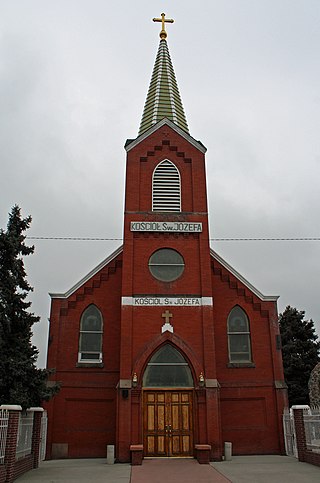
Globeville is a neighborhood of Denver, Colorado. Globeville is located in the area traditionally called North Denver.
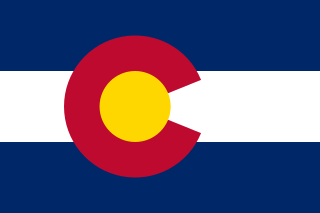
The following outline is provided as an overview of and topical guide to the U.S. state of Colorado:
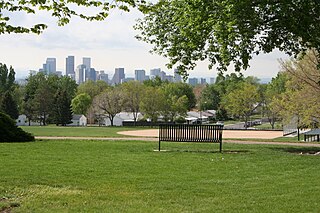
Chaffee Park is a neighborhood in Denver, Colorado located in the northwest corner of the city. Chaffee Park is north of Sunnyside connected via Zuni Street, and northeast of Berkeley connected through Regis via nearby Lowell Boulevard. Chaffee Park is east of Regis and south of Adams County.
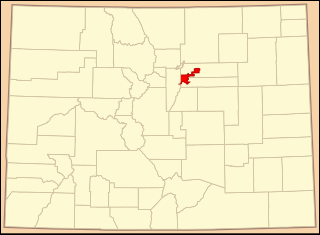
Central Park, previously Stapleton, is a neighborhood within the city limits of Denver and Aurora, Colorado. Located east of downtown Denver, the neighborhood is at the former site of the decommissioned Stapleton International Airport, which closed in 1995. It is the largest residential neighborhood within the city of Denver. The Central Park Neighborhood contains twelve specifically named sub-neighborhoods, 11 public/private schools, 50 parks, 7 pools, several shopping and business districts, a city of Denver recreation center, and a Denver library. The latest population as of 2022 is estimated at 30,000.
The North East Side (Denver), is a region/area located in both Denver County and Adams County. The neighborhoods located within Denver's north east side are Elyria-Swansea, Commerce City, and Derby. As of the 2007 Denver Piton Foundation and the United States Census Bureau, the region/area had a total population of 53,541 people.
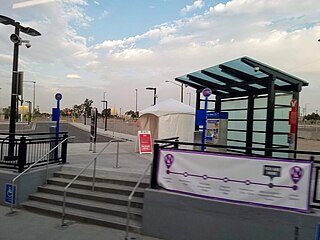
48th & Brighton / National Western Center station is a station on the N Line of the Denver RTD commuter rail system in Denver, Colorado. It is the first station northbound from Union Station and is located on the edge of the Elyria-Swansea neighborhood. The station opened on September 21, 2020.
Carolína Acuña Díaz González (1894–1996) was a businesswoman and activist in the Denver Latinx community. In the 1950s, she opened "Casa Mayan," a prominent restaurant and community gathering space.
Lorraine Granado was an American environmental, peace and social justice activist and organizer who was the founder and executive director of the Cross Community Coalition in Denver, Colorado, the co-founder of the Colorado People's Environmental and Economic Network, the co-founder of Neighbors for a Toxic-Free Community in Denver, and the co-director of the Rocky Flats Disarmament and Human Needs Project.

















